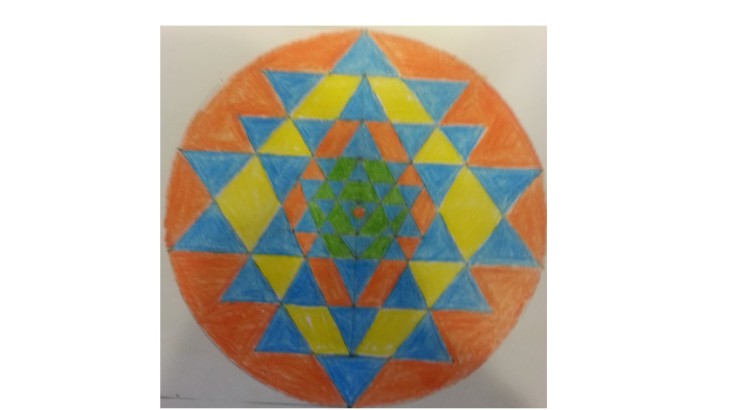
Sri Chakra representation drawn by Jayant Kalawar
By Jayant Kalawar
In the 22 mantras, spanning the 90th through 111, the LalitA SahasranAmA (those unfamiliar, please read this overview link) describes how LalitAmbA, Mother LalitA plays within us, as She rises from the MooldhArA to the SahasrArA.
The 90th mantra describes her at the top in the Sahasrara:
kuḷāmṛtaika rasikā
This mantra occurs in the 36th verse of the LalitA SahasranAmA, which is:
mūlamantrātmikā, mūlakūṭa traya kaḷebarā |
kuḷāmṛtaika rasikā, kuḷasaṅketa pālinī || 36 ||
(Listen)
The vibration of the mantra connect us to LalitAmbA, LalitA-Mother (AmbA). Listen to the link above and chant the mantra. You are calling out to the Devi LalitA, the Mother (Devi pronounced it as They-vi, for those unfamiliar with SamskrutA). And the Mother responds to your call.
Many of us though would like to know the ‘meaning’ of the mantra. That helps too, as it helps to create a visualization. How to chant a particular mantra with what focus and visualization is best as a one-on-one conversation. The vibration of the mantra along with the visualization can and does begin to change the vibrational structure of the individual. It is something to be learned when one is ready to begin connecting with the more subtle aspects of oneself, after gradually stepping away from the attachments of sense based objects.
Just to give a high level sense of the verse:
Rasika is the enjoyer. LalitAmbA is playing and enjoying. What is She enjoying?
Amrut: that which is opposite of Mrut, death. Non-Death. LalitAmba enjoys the state of Non-Death when She reaches the SahasrArA, where she meets and dances with ShivA.
Shiva is always sitting in meditation bathing in peaceful moonlight at the Sahasrara. Awaiting his beloved LalitAmbA to join Him.
LalitAmbA works through a series of obstacles to rise from the MooldhArA to meet her beloved ShivA in SahasrArA.
She awakens Him out of his meditative state in the Sahasrara. They begin their celestial dance.
And the Amrut, Non-Death, flows in the subtle plane.
In the physical plane it flows out of Kula: the body.
Hence, the practitioner tastes the sweetness when the Devi Shakti reaches the SahasrArA. It flows as KulAmrut.
For LalitAmbA is indeed the RasikA, the enjoyer, of KulAmrut. Hence KulAmrutaikarasikA.
The reader may have noticed, in the description above, how gender apparently seems to play a role. The feminine principle, LalitA rises to meet the male principle, Shiva.
Where does this take place? In each of our individual subtle bodies. So in that sense, each one of us has something that we may categorize as feminine and also masculine.
It is the meeting of these two principles within each of us culminates in the subtle celestial dance, which produces the A-Mruta, the Non-Death state.
It is also interesting to note that the 1000 mantras of LalitA are roughly divided, in terms of gender ascription, into one third feminine gender nouns, one third masculine gender nouns and the rest as neuter gender nouns.
Many of you may be interested to know more about how both the feminine and masculine principles play a role in each of us. I have written more about that here.

[…] my previous post may give the reader context for this […]
LikeLike
[…] KulAmrutarasikA: the 90th Mantra of the LalitAsahasranAmA […]
LikeLike